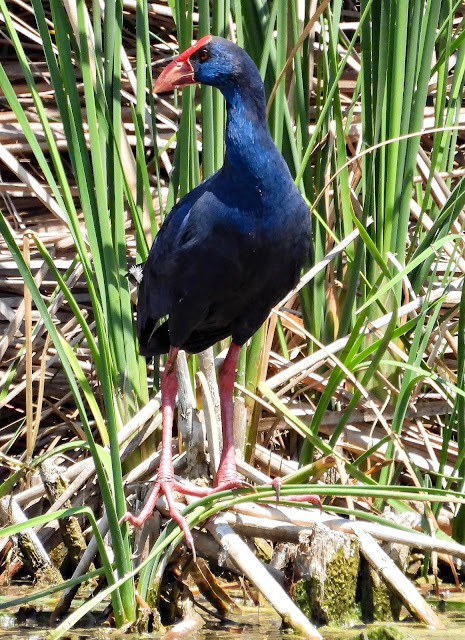
The western swamphen (known as Purple Swamphen) (Porphyrio porphyrio ) is a swamphen in the rail family Rallidae, one of the six species of purple swamphen. From the French name talève sultane, it is also known as the sultana bird. This chicken-sized bird, with its large feet, bright plumage and red bill and frontal shield is easily recognisable in its native range. It used to be considered the nominate subspecies of the purple swamphen, but is now recognised as a separate species. The western swamphen is found in wetlands in Spain (where the largest population lives), Portugal, southeastern France, Italy (Sardinia and Sicily) and northwestern Africa (Morocco, Algeria and Tunisia).
Quite common although very local in the Mediterranean region, occasional escapes occur in northern Europe. Prefers freshwater wetlands. It moves through the interior of large reed beds and reed beds; it also feeds on the margins of the vegetation or even in the adjacent wet meadows. It is characterized by being a large rail, much larger than a redfish. Its plumage is generally dark purplish blue, with a very robust red beak and reddish legs, and a white undertail spot. The young ones are basically grayish, appearing duller overall.
The species makes loud, quick, bleating and hooting calls which are hardly bird-like in tone. It is particularly noisy during the breeding season. Despite being clumsy in flight, it can fly long distances and is a good swimmer, especially for a bird without webbed feet.
The western swamphen prefers wet areas with high rainfall, swamps, lake edges and damp pastures. The birds often live in pairs and larger communities. It clambers through the reeds, eating the tender shoots and vegetable-like matter. They have been known to eat eggs, ducklings, small fish and invertebrates such as snails. They have even been known to attack large eels; however, there is no consensus amongst ornithologists if they actually eat eel. They will often use one foot to bring food to their mouth rather than eat it on the ground. Where they are not persecuted they can become tame and be readily seen in towns and cities.

Pairs nest in a large pad of interwoven reed flags, etc., on a mass of floating debris or amongst matted reeds slightly above water level in swamps, clumps of rushes in paddocks or long unkempt grass. Each bird can lay 3–6 speckled eggs, pale yellowish stone to reddish buff, blotched and spotted with reddish brown. The incubation period is 23–27 days, and is performed by both sexes. The precocious chicks are feathered with downy black feathers and able to leave the nest soon after hatching, but will often remain in the nest for a few days. Young chicks are fed by their parents (and group members) for between 10–14 days, after which they begin to feed themselves.
Today the western swamphen is locally common, with the largest population in Spain. It was formerly listed as "Rare" by the European Union, but has been delisted to "Localised".
The species declined drastically in the first half of the 20th century due to habitat loss and hunting. It was relatively widespread until 1900, but by the 1960s it was seriously threatened and its range in the Iberian Peninsula was limited to a few locations in the Guadalquivir basin. As a result of reintroduction schemes and protection of both the species and its habitat, the western swamphen has since recovered. By the 1990s it was locally common, and by 2000 its range in the Iberian Peninsula was similar to its range in 1900. The center is in Spain where the population increased from 600–900 breeding pairs in 1992 to 3500–4500 breeding pairs in 1999. From Spain it has continued its expansion into southeastern France where small numbers now breed.

Little is known about the status of the western swamphen in Africa, but northeastern Algeria is considered one of its strongholds in this region.
When protected, western swamphens are able to thrive in human-managed habitats, and in some places they live in paddy fields, resulting in conflicts with farmers as they can be destructive to the rice.
%201.jpg)
%202.jpg)
%201.jpg)
%201.jpg)
%202.jpg)
%202.jpg)



%201.jpg)
%202.jpg)
%203.jpg)
%201.jpg)
%202.jpg)
1.jpg)


%2020.jpg)
%2021.jpg)
%2022.jpg)









%2024.jpg)

%201.jpg)
%202.jpg)










%201.jpg)
%202.jpg)